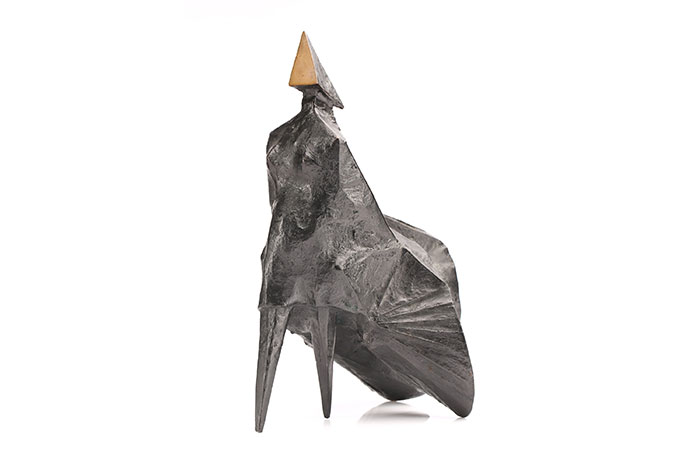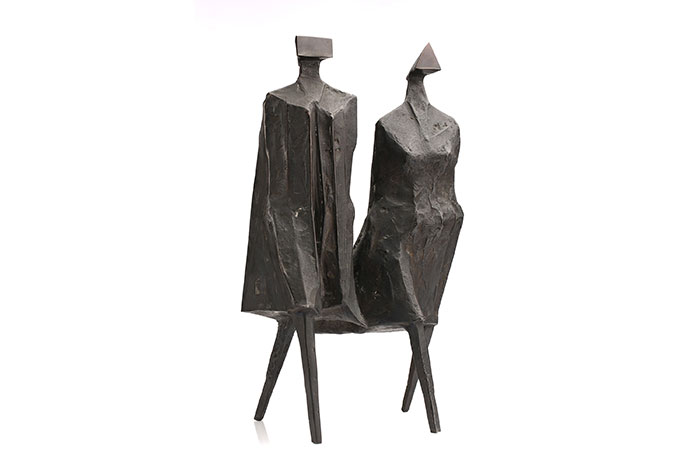A Guide to the Work of Lynn Russell Chadwick
Known for his expressive abstract bronze and steel sculptures, he pioneered new approaches to art
30/07/2025
Lynn Russell Chadwick was a renowned British artist and sculptor, best known for his expressive abstract bronze and steel sculptures, he helped pioneer new approaches to this visual art. He welded iron and bronze in favour of traditional methods of carving wood or stone. Chadwick's work is characterised by angular, geometric figures depicting humanlike or otherwise biomorphic forms.
Born on the 24th of November in 1914 in Barnes, West London, Chadwick went to Merchant Taylor’s School. He studied architecture and worked as a draughtsman under Donald Hamilton, Eugen Carl Kauffman, and most significantly for Rodney Thomas.
"What it taught me was how to compose things, a formal exercise in composition, really, it has nothing to do with the building it represents" – Lynn Russell Chadwick.
During World War II Chadwick worked as a farm labourer before volunteering for the Fleet Air Arm, Royal Navy. After qualifying as a pilot in Canada, Chadwick flew escorting and protecting convoy planes in the North Atlantic from 1941 until 1944. He married his first wife, Ann Secord, and fathered a son, Simon in 1942. After the war he resumed work with Rodney Thomas designing trade-fair stands. In 1946 he relocated to the village of Stroud in Gloucestershire. It was around this time that he created his first mobile sculpture, inspired by Rodney Thomas’s idea of moving sculptural objects, it was shown at the Builder's Trades Exhibition. These fragile works were made from wire, balsa wood, copper, and brass. Chadwick later developed ground supports for these mobiles referring to them as "stabiles".
“If I look back on my work over a period of years, I can see a development from mobiles and constructions, on to beaten shapes with limbs and collections, to the solid forms on which I'm now working. It seems there has been a deliberate continuity, as if the mobiles had been a research into space and volume (separate parts free in space), and the constructions had been a way of joining the parts together, fixing them in space to make forms, and that these constructions have become armatures for the solid shapes - the iron frames of the construction still delineate the mass and act as lines of tension” - Lynn Russell Chadwick, The New Decade: 22 European painters and sculptors, Museum of Modern Art, New York, 1955.
Lynn Russell Chadwick 'Maquette II Walking Woman'
In August 1949 one of Chadwick’s mobiles appeared in the window of modern art gallery Gimpel Fils, and in June 1950 he held his first solo exhibition there. He quickly gained recognition and was commissioned to make three large constructions for the 1951 Festival of Britain; “Tower” mobile for the Riverside restaurant, and “Cypress” Stabile which was placed in the garden of the Regatta Restaurant and “The Fisheater”, a large sculpture for the Arts Council of Great Britain which was exhibited in the Tate Gallery. During this time, he enrolled in a welding course at the British Oxygen Company's Welding School at Cricklewood, north London. He also exhibited “Green Finger” at the Battersea Park Open Air Sculpture Exhibition in the same year. These works are significant of Chadwick’s transition from designer to sculptor.
In 1951 he was invited to exhibit in New York with the American Abstract Artists Group and in 1952 he held his second solo exhibition at Gimples, which was also shown at the Galerie de France in Paris. Chadwick gained international attention when he was included in the British Council exhibition “New Aspects of British Sculpture” for the XXVI Biennale in Venice alongside key sculptors including Robert Adams, Kenneth Armitage, Reg Butler, Geoffrey Clarke, Bernard Meadows, Eduardo Paolozzi and William Turnbull. The following year he was one of the twelve semi-finalists for the 1953 Unknown Political Prisoner International Sculpture Competition.
In 1956 Chadwick’s reputation was assured when he won the International Prize for sculpture at that year's Venice Biennale - he was the youngest ever recipient of the award beating Alberto Giacometti, César Baldaccini and Germaine Richier. His work undoubtedly caught the post-war mood and throughout the 1950s remained largely abstract with suggestions of natural forms. Chadwick bought Lypiatt Park in 1958, a historic Neo-Gothic manor house which became his home, project, and studio for the remainder of his life.
Following his divorce, Chadwick married Frances Jamieson in 1959 with whom he had two daughters, Sarah and Sophie. The couple divorced in 1964 and the following year he married Éva Reiner, together they had one son, Daniel. Éva was a refugee from Budapest and remained his constant companion and cataloguer of his life’s work.
From the early 1960s, Chadwick had a steady flow of public commissions and private sales in America and Europe, particularly in Italy. His work shifted becoming more block-like and monumental, towards the end of the decade he had started working on complex groupings of figures. These simplified forms featuring pyramidal or diamond shaped heads for females and rectangular block shaped heads for males are amongst Chadwick’s most recognisable works.
Lynn Russell Chadwick 'Walking Couple III', bronze
He was named a Commander of the Order of the British Empire in 1964 and a Commandeur des Arts et des Lettres in 1993. He opened his own foundry at Lypiatt Park in 1971 where he began to install his own bronze works in the gardens.
Chadwick's sculptures often feature interlocking, angular shapes that suggest movement and tension. Many of his works explore themes of the human condition, expressing emotions like anxiety, isolation, and vulnerability through their abstract forms.
Failing eyesight forced Chadwick to retire in 1996, and on the 25th of April 2003 he died at home. When he passed away, he was aware of plans for the Tate to hold a major retrospective on his works later that year.
Throughout his prolific career, Chadwick received numerous accolades, and in Britain, he became widely considered as a successor to Henry Moore as a leading sculptor and artistic ambassador for the next generation. His work has been exhibited in New York, London, Berlin, Paris, Hong Kong, Milan, Tokyo, and Los Angeles. His sculptures can be found in most major museum collections around the world, and his works have fetched huge sums at auction – in 2018 a work entitled ‘Pair of Walking Figures – Jubilee’ sold for nearly $3.5m.
RELATED ARTICLES
How Much is Contemporary Art Worth?
A Guide to the Work of Barbara Hepworth
How Can I Sell an Art Collection?
Are you considering selling any artwork by Lynn Chadwick?
With a huge global audience of over 10 million active bidders, Dawsons can secure the highest prices.
Get in touch with an expert valuer for confidential sales advice, we would be delighted to help you:

